Unit 10 I'd like some noodles. Section A (2 d - grammar focus )课件(34张PPT内嵌音频)
文档属性
| 名称 | Unit 10 I'd like some noodles. Section A (2 d - grammar focus )课件(34张PPT内嵌音频) | 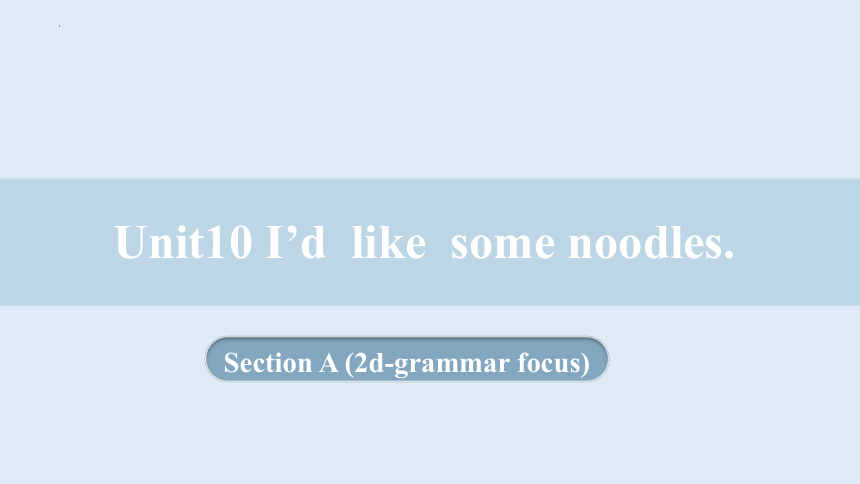 | |
| 格式 | pptx | ||
| 文件大小 | 3.6MB | ||
| 资源类型 | 教案 | ||
| 版本资源 | 人教新目标(Go for it)版 | ||
| 科目 | 英语 | ||
| 更新时间 | 2022-03-20 22:33:24 | ||
图片预览

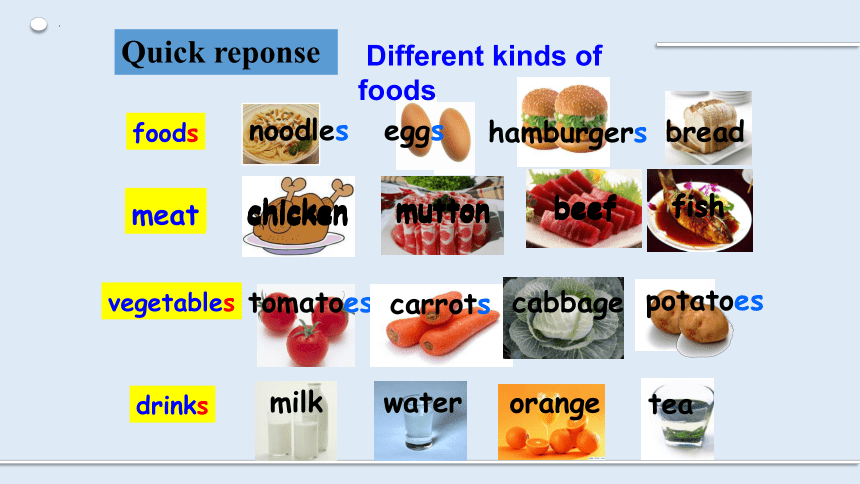
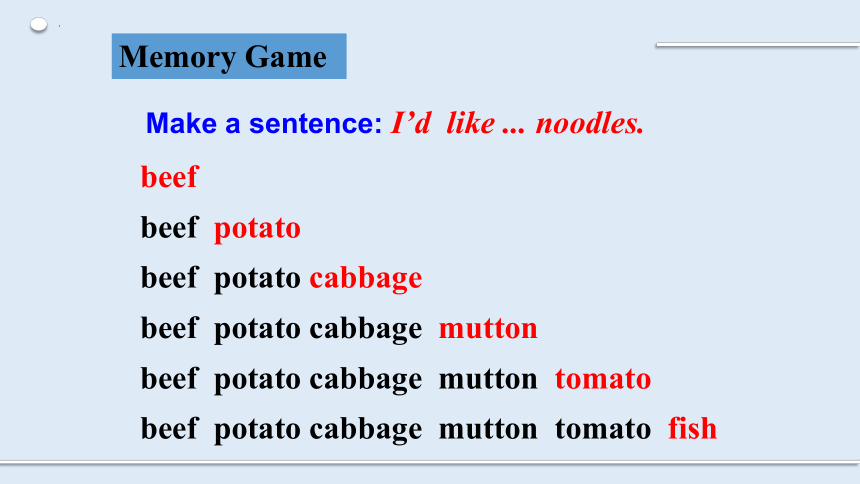
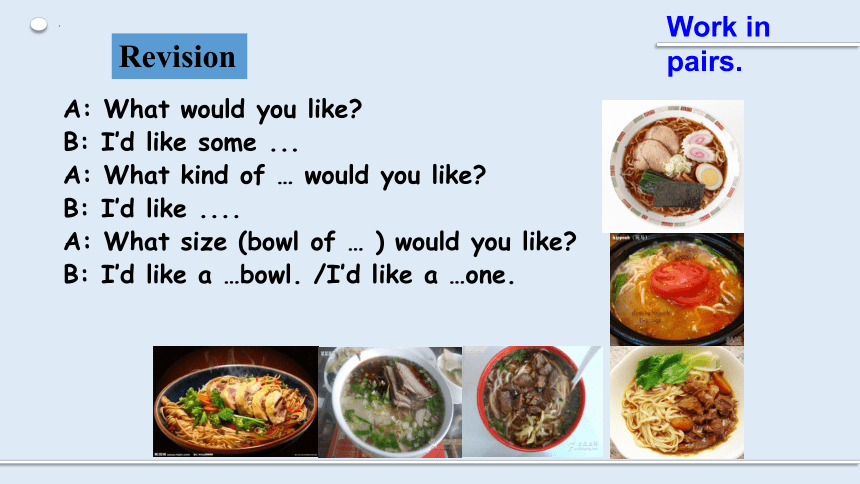
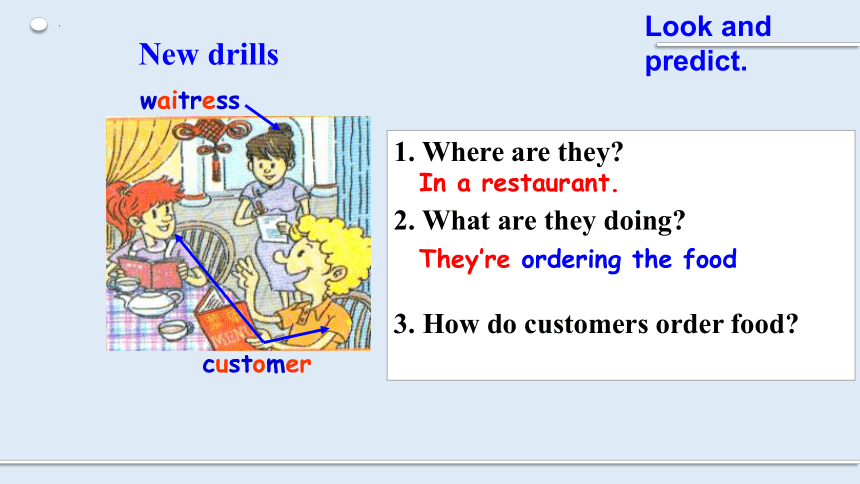
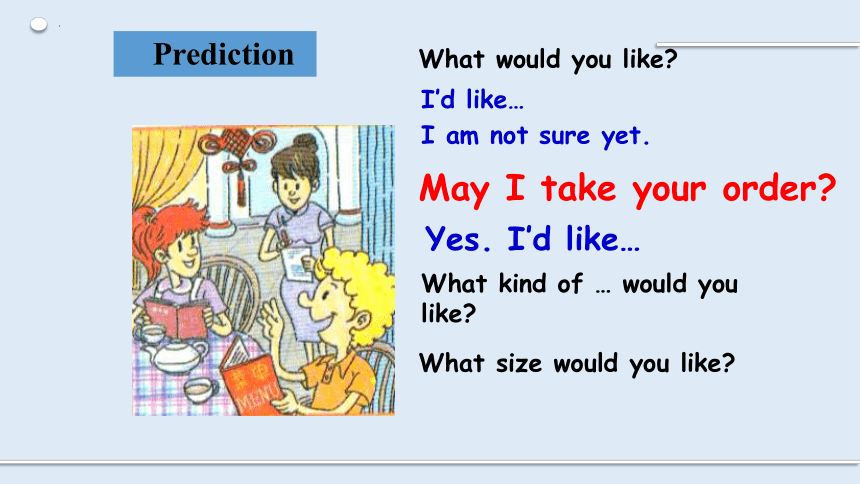
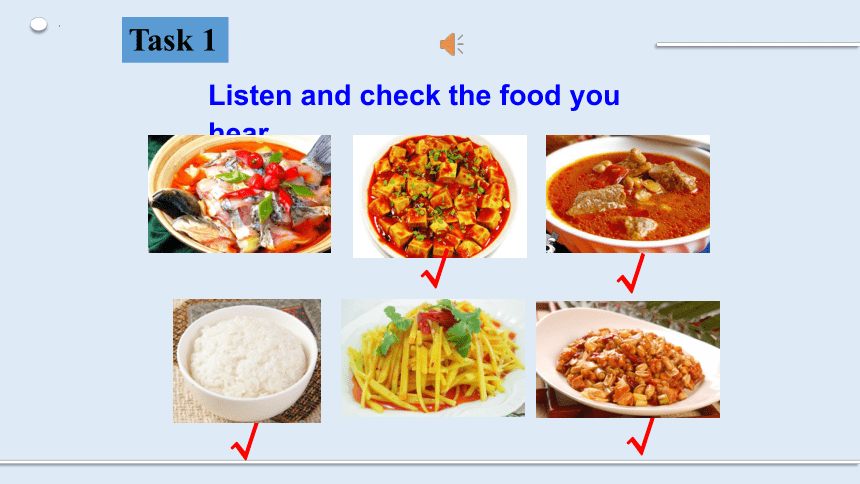


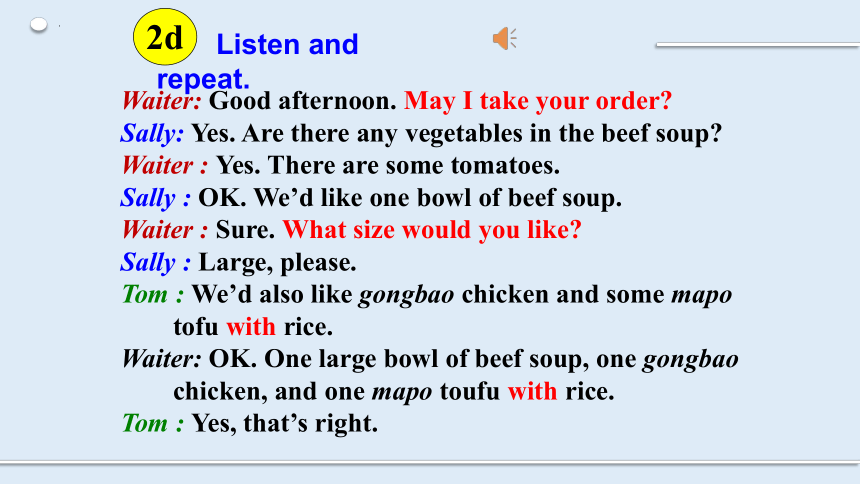
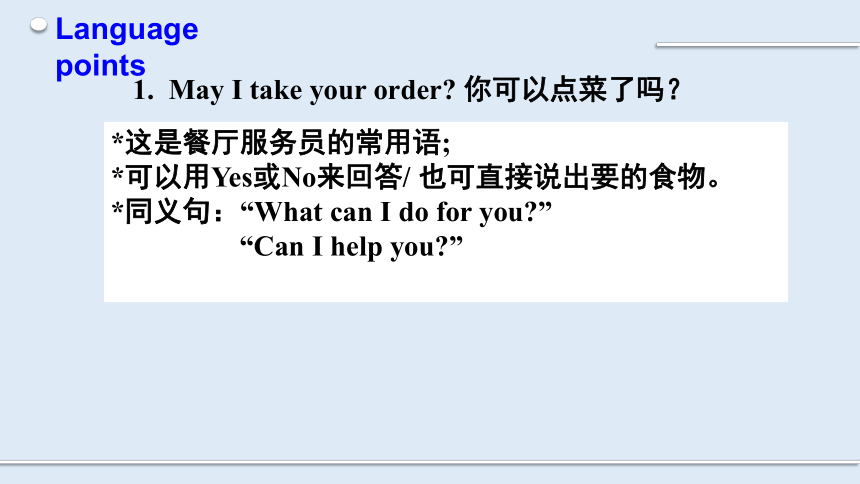
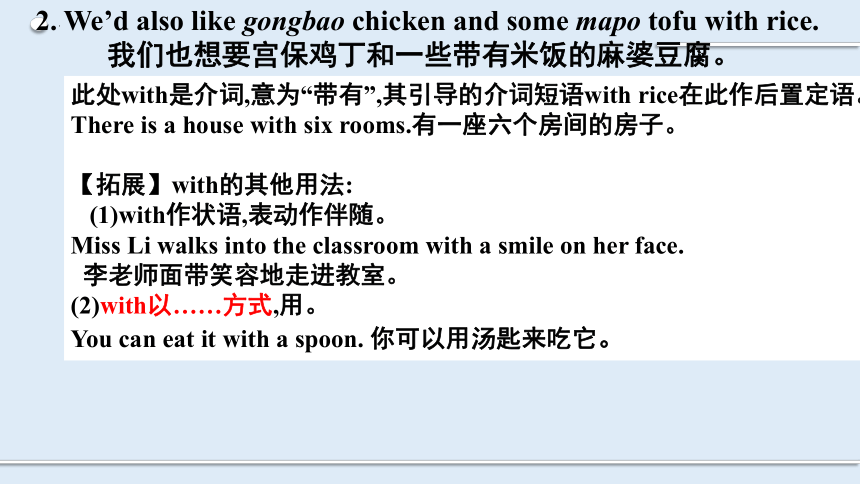
文档简介
(共34张PPT)
Unit10 I’d like some noodles.
Section A (2d-grammar focus)
chicken
mutton
beef
fish
meat
tomatoes
carrots
cabbage
potatoes
vegetables
milk
water
orange
tea
drinks
foods
noodles
eggs
hamburgers
bread
Quick reponse
Different kinds of foods
chicken
meat
mutton
chicken
meat
beef
mutton
chicken
meat
fish
beef
mutton
chicken
meat
Make a sentence: I’d like ... noodles.
beef
beef potato
beef potato cabbage
beef potato cabbage mutton
beef potato cabbage mutton tomato
beef potato cabbage mutton tomato fish
Memory Game
Revision
Work in pairs.
A: What would you like
B: I’d like some ...
A: What kind of … would you like
B: I’d like ....
A: What size (bowl of … ) would you like
B: I’d like a …bowl. /I’d like a …one.
1. Where are they
2. What are they doing
3. How do customers order food
New drills
customer
They’re ordering the food
waitress
Look and predict.
In a restaurant.
What would you like
May I take your order
I’d like…
I am not sure yet.
Yes. I’d like…
What kind of … would you like
What size would you like
Prediction
Listen and check the food you hear.
√
√
√
√
Task 1
1. Are there any tomatoes in the beef soup
2. What vegetables in the beef soup
3. What size would they like
Yes, there are.
some tomatoes.
Large.
Listen again and answer the questions.
Task 2
What would Sally like
What would Tom like
Read and answer the questions.
She’d like a bowl of beef soup.
He'd like gongbao chicken and some mapo tofu with rice .
Task 3
.
Listen and repeat.
2d
Waiter: Good afternoon. May I take your order
Sally: Yes. Are there any vegetables in the beef soup
Waiter : Yes. There are some tomatoes.
Sally : OK. We’d like one bowl of beef soup.
Waiter : Sure. What size would you like
Sally : Large, please.
Tom : We’d also like gongbao chicken and some mapo tofu with rice.
Waiter: OK. One large bowl of beef soup, one gongbao chicken, and one mapo toufu with rice.
Tom : Yes, that’s right.
1. May I take your order 你可以点菜了吗?
*这是餐厅服务员的常用语;
*可以用Yes或No来回答/ 也可直接说出要的食物。
*同义句:“What can I do for you ”
“Can I help you ”
Language points
2. We’d also like gongbao chicken and some mapo tofu with rice. 我们也想要宫保鸡丁和一些带有米饭的麻婆豆腐。
此处with是介词,意为“带有”,其引导的介词短语with rice在此作后置定语。
There is a house with six rooms.有一座六个房间的房子。
【拓展】with的其他用法:
(1)with作状语,表动作伴随。
Miss Li walks into the classroom with a smile on her face.
李老师面带笑容地走进教室。
(2)with以……方式,用。
You can eat it with a spoon. 你可以用汤匙来吃它。
Group work
A: May I take your order
B: Yes, please.
A: What would you like
B: I’d like some ....
A: What kind of ... would you like
B: I’d like…
A: What size (bowl of ...) would you like
B:I’d like a....bowl.
A:OK.Wait a minute(稍等一会儿).
一起到餐厅吃东西吧!
Good afternoon. May I ..
Yes. Are there...
Role play
Role-play the conversation.
1. Read the dialogue. 能够与小组成员合作朗读对话。
2. Role—play the dialogue. 语音、语调准确,能够表演对话。
What kind of noodles do you like I’d like beef noodles, please.
What size would you like I’d like a large bowl, please.
Would you like a large bowl Yes, please.
Is there any meat in the tomato and egg soup No, there isn’t any. / No, there is no meat.
Grammar
Focus
Countable nouns
bowls, apples, carrots, oranges, strawberries
Uncountable nouns
beef, meat, milk, mutton, water
Countable and uncountable nouns
chicken, salad, ice-cream, cabbage, cake
1. 你想要什么面条?
________________________________
2. 请给我来牛肉面。________________________________
3. 你想要什么碗的?________________________________
4. 请给我来大碗的。
___________________________
阅读Grammar Focus部分, 完成下列句子。
I’d like beef noodles, please.
What kind of noodles would you like
What size would you like
Grammar focus
I’d like a large bowl, please.
5. 你想来一个大碗吗?
___________________________
6. 好的。
___________________________
Would you like a large bowl
Yes, please.
7. 西红柿鸡蛋汤里有肉吗
_______________________________________
不,没有。
__________________________________
No, there isn’t any. /No, there’s no meat.
Is there any meat in the tomato and egg soup
11. 可数名词有:bowls, apples, carrots, _______________________
12. 不可数名词有:bread, milk, water,
_______________________________
13. 既是可数又是不可数的名词:salad, chicken, ice cream, ______________
cabbage, cake
beef, meat, mutton
9. I’d = ____________
10. She’d = _________
I would
She would
oranges, strawberries
cake, oranges, mutton, beef, cabbage, meat,
strawberries
1. would like意为“想要某物”,常用句式结构:
你想要点什么?
What ______ you ______
我想要一杯茶。
____ _____ a cup of tea.
I’d like
would like
would like 句型
语法专讲
你想要什么面条?
What _____ of noodles ______ you like
你想要多大号的毛衣?
What ____ of sweater ______ you like
(以上句型为有礼貌、委婉地表达征求对方的要求)
kind would
size would
2. Would you like … 你想要……吗?这也是用来向对方有礼貌地、语气委婉地征求对方要求的句型。其答语为: Yes, please. /OK. /No, thanks.
你想要一些牛奶吗?
______ you _____ some milk
是的,谢谢。/ 不,谢谢。
Yes, _______. / No, _______.
please thanks
Would like
【拓展】Would you like to do sth. 你愿意做某事吗?
用来有礼貌地向对方提出建议或邀请的句型。答语常为“Yes, I’d like to.” / “Sorry, …”。
你愿意和我们一起去划船吗?
______ you ____ to ____ boating with us
Would like go
1. 可数名词:可数名词有单数、复数之 分。其复数形式一般要加-s或-es。 如: potato — _________
tomato — __________
2. 不可数名词没有复数形式,只有单数形式。如:
some ______ (米饭)
a lot of _____ (牛肉)
rice
beef
potatoes
tomatoes
可数名词不可数名词
语法专讲
(1) 不可数名词表示数量的多少时,必须与表示数量的名词连用,即“数词 + 表示数量的名词(可数名词)+ of + 不可数名词”。如:
两玻璃杯果汁
_____ ________ of juice
三碗米饭
_______ ______ of rice
three bowls
two glasses
(2) 不可数名词做主语时,谓语动词只能用单数形式。例如:
碗里有一些羊肉汤。
There ___ ______ mutton soup in the bowl.
【拓展】如果不可数名词前有复数名词短 语修饰时,谓语动词须用复数形式。
如:房间里有两袋大米。
______ ____ two bags of rice in the room.
is some
There are
countable nouns可数名词
uncountable
nouns不可数名词
countable &
uncountable
可数和不可数名词
rice
chicken
food
egg
carrot
ice-cream
tomato
strawberr
milk
s
es
s
ies
y
apple
orange
beef
meat
mutton
water
cake
salad
s
s
a. What kind of noodles do you have
b. Oh, a medium bowel, please.
c. OK, I’d like the mutton noodles then.
d. I’d like some noodles, please.
e. What size do you have
f. Are there any vegetables in the mutton noodles
1. May I have your order ___
2. What kind of noodles would you like ___
3. We have beef, chicken, mutton, cabbage, potato, tomato … ____
4. Yes, there are some carrots. ____
5. Sure. What size would you like ____
6. We have large, medium and small bowels. ____
d
Complete the conversation below.
3a
先通读一遍问句与答语部分的选项,整体把握对话的大意,明确对话中顾客想要吃的食物。
2. 开头的问答句,已给出答案了,因此应按说话的逻辑顺序,顺藤摸瓜。
方法指导
a. What kind of noodles do you have
b. Oh, a medium bowel, please.
c. OK, I’d like the mutton noodles then.
d. I’d like some noodles, please.
e. What size do you have
f. Are there any vegetables in the mutton noodles
1. May I have your order ___
2. What kind of noodles would you like ___
3. We have beef, chicken, mutton, cabbage, potato, tomato … ____
4. Yes, there are some carrots. ____
5. Sure. What size would you like ____
6. We have large, medium and small bowels. ____
d
a
f
e
b
c
Complete the conversation below.
3a
1. What kind of noodles would you like (kind)
____________________________________
__________ (chicken/beef/tomatoes)
2. _________________________(size)
_____________________________(medium)
3. ____________________________________
(any/cabbage/beef noodles)
____________________________ (no)
I’d like the chicken/beef noodles with tomatoes.
What size would you like
Are there any cabbages in the beef noodles
I’d like a medium bowl of noodles.
No, there aren’t any cabbages.
Write questions and answers using the words in brackets.
3b
3c
Work in small groups. Who would like the food below Write their names on the cards above the food.
A: Anna, what would you like to eat
B: I’d like beef noodles with carrots.
Food
Size:
Small/medium/large bowl of
Structures:
A: What kind of…/size would you like
B: I’d like…, please.
A: Would you like….
B: Yes, please./No, thanks.
A: Is/Are there any… in ….
B: Yes, there is/are./No, there isn’t/aren’t.
Food names:
Meat: mutton, beef, fish
Vegetables: cabbage, potato, tomato
Other: noodles, tofu…
Summary
Unit10 I’d like some noodles.
Section A (2d-grammar focus)
chicken
mutton
beef
fish
meat
tomatoes
carrots
cabbage
potatoes
vegetables
milk
water
orange
tea
drinks
foods
noodles
eggs
hamburgers
bread
Quick reponse
Different kinds of foods
chicken
meat
mutton
chicken
meat
beef
mutton
chicken
meat
fish
beef
mutton
chicken
meat
Make a sentence: I’d like ... noodles.
beef
beef potato
beef potato cabbage
beef potato cabbage mutton
beef potato cabbage mutton tomato
beef potato cabbage mutton tomato fish
Memory Game
Revision
Work in pairs.
A: What would you like
B: I’d like some ...
A: What kind of … would you like
B: I’d like ....
A: What size (bowl of … ) would you like
B: I’d like a …bowl. /I’d like a …one.
1. Where are they
2. What are they doing
3. How do customers order food
New drills
customer
They’re ordering the food
waitress
Look and predict.
In a restaurant.
What would you like
May I take your order
I’d like…
I am not sure yet.
Yes. I’d like…
What kind of … would you like
What size would you like
Prediction
Listen and check the food you hear.
√
√
√
√
Task 1
1. Are there any tomatoes in the beef soup
2. What vegetables in the beef soup
3. What size would they like
Yes, there are.
some tomatoes.
Large.
Listen again and answer the questions.
Task 2
What would Sally like
What would Tom like
Read and answer the questions.
She’d like a bowl of beef soup.
He'd like gongbao chicken and some mapo tofu with rice .
Task 3
.
Listen and repeat.
2d
Waiter: Good afternoon. May I take your order
Sally: Yes. Are there any vegetables in the beef soup
Waiter : Yes. There are some tomatoes.
Sally : OK. We’d like one bowl of beef soup.
Waiter : Sure. What size would you like
Sally : Large, please.
Tom : We’d also like gongbao chicken and some mapo tofu with rice.
Waiter: OK. One large bowl of beef soup, one gongbao chicken, and one mapo toufu with rice.
Tom : Yes, that’s right.
1. May I take your order 你可以点菜了吗?
*这是餐厅服务员的常用语;
*可以用Yes或No来回答/ 也可直接说出要的食物。
*同义句:“What can I do for you ”
“Can I help you ”
Language points
2. We’d also like gongbao chicken and some mapo tofu with rice. 我们也想要宫保鸡丁和一些带有米饭的麻婆豆腐。
此处with是介词,意为“带有”,其引导的介词短语with rice在此作后置定语。
There is a house with six rooms.有一座六个房间的房子。
【拓展】with的其他用法:
(1)with作状语,表动作伴随。
Miss Li walks into the classroom with a smile on her face.
李老师面带笑容地走进教室。
(2)with以……方式,用。
You can eat it with a spoon. 你可以用汤匙来吃它。
Group work
A: May I take your order
B: Yes, please.
A: What would you like
B: I’d like some ....
A: What kind of ... would you like
B: I’d like…
A: What size (bowl of ...) would you like
B:I’d like a....bowl.
A:OK.Wait a minute(稍等一会儿).
一起到餐厅吃东西吧!
Good afternoon. May I ..
Yes. Are there...
Role play
Role-play the conversation.
1. Read the dialogue. 能够与小组成员合作朗读对话。
2. Role—play the dialogue. 语音、语调准确,能够表演对话。
What kind of noodles do you like I’d like beef noodles, please.
What size would you like I’d like a large bowl, please.
Would you like a large bowl Yes, please.
Is there any meat in the tomato and egg soup No, there isn’t any. / No, there is no meat.
Grammar
Focus
Countable nouns
bowls, apples, carrots, oranges, strawberries
Uncountable nouns
beef, meat, milk, mutton, water
Countable and uncountable nouns
chicken, salad, ice-cream, cabbage, cake
1. 你想要什么面条?
________________________________
2. 请给我来牛肉面。________________________________
3. 你想要什么碗的?________________________________
4. 请给我来大碗的。
___________________________
阅读Grammar Focus部分, 完成下列句子。
I’d like beef noodles, please.
What kind of noodles would you like
What size would you like
Grammar focus
I’d like a large bowl, please.
5. 你想来一个大碗吗?
___________________________
6. 好的。
___________________________
Would you like a large bowl
Yes, please.
7. 西红柿鸡蛋汤里有肉吗
_______________________________________
不,没有。
__________________________________
No, there isn’t any. /No, there’s no meat.
Is there any meat in the tomato and egg soup
11. 可数名词有:bowls, apples, carrots, _______________________
12. 不可数名词有:bread, milk, water,
_______________________________
13. 既是可数又是不可数的名词:salad, chicken, ice cream, ______________
cabbage, cake
beef, meat, mutton
9. I’d = ____________
10. She’d = _________
I would
She would
oranges, strawberries
cake, oranges, mutton, beef, cabbage, meat,
strawberries
1. would like意为“想要某物”,常用句式结构:
你想要点什么?
What ______ you ______
我想要一杯茶。
____ _____ a cup of tea.
I’d like
would like
would like 句型
语法专讲
你想要什么面条?
What _____ of noodles ______ you like
你想要多大号的毛衣?
What ____ of sweater ______ you like
(以上句型为有礼貌、委婉地表达征求对方的要求)
kind would
size would
2. Would you like … 你想要……吗?这也是用来向对方有礼貌地、语气委婉地征求对方要求的句型。其答语为: Yes, please. /OK. /No, thanks.
你想要一些牛奶吗?
______ you _____ some milk
是的,谢谢。/ 不,谢谢。
Yes, _______. / No, _______.
please thanks
Would like
【拓展】Would you like to do sth. 你愿意做某事吗?
用来有礼貌地向对方提出建议或邀请的句型。答语常为“Yes, I’d like to.” / “Sorry, …”。
你愿意和我们一起去划船吗?
______ you ____ to ____ boating with us
Would like go
1. 可数名词:可数名词有单数、复数之 分。其复数形式一般要加-s或-es。 如: potato — _________
tomato — __________
2. 不可数名词没有复数形式,只有单数形式。如:
some ______ (米饭)
a lot of _____ (牛肉)
rice
beef
potatoes
tomatoes
可数名词不可数名词
语法专讲
(1) 不可数名词表示数量的多少时,必须与表示数量的名词连用,即“数词 + 表示数量的名词(可数名词)+ of + 不可数名词”。如:
两玻璃杯果汁
_____ ________ of juice
三碗米饭
_______ ______ of rice
three bowls
two glasses
(2) 不可数名词做主语时,谓语动词只能用单数形式。例如:
碗里有一些羊肉汤。
There ___ ______ mutton soup in the bowl.
【拓展】如果不可数名词前有复数名词短 语修饰时,谓语动词须用复数形式。
如:房间里有两袋大米。
______ ____ two bags of rice in the room.
is some
There are
countable nouns可数名词
uncountable
nouns不可数名词
countable &
uncountable
可数和不可数名词
rice
chicken
food
egg
carrot
ice-cream
tomato
strawberr
milk
s
es
s
ies
y
apple
orange
beef
meat
mutton
water
cake
salad
s
s
a. What kind of noodles do you have
b. Oh, a medium bowel, please.
c. OK, I’d like the mutton noodles then.
d. I’d like some noodles, please.
e. What size do you have
f. Are there any vegetables in the mutton noodles
1. May I have your order ___
2. What kind of noodles would you like ___
3. We have beef, chicken, mutton, cabbage, potato, tomato … ____
4. Yes, there are some carrots. ____
5. Sure. What size would you like ____
6. We have large, medium and small bowels. ____
d
Complete the conversation below.
3a
先通读一遍问句与答语部分的选项,整体把握对话的大意,明确对话中顾客想要吃的食物。
2. 开头的问答句,已给出答案了,因此应按说话的逻辑顺序,顺藤摸瓜。
方法指导
a. What kind of noodles do you have
b. Oh, a medium bowel, please.
c. OK, I’d like the mutton noodles then.
d. I’d like some noodles, please.
e. What size do you have
f. Are there any vegetables in the mutton noodles
1. May I have your order ___
2. What kind of noodles would you like ___
3. We have beef, chicken, mutton, cabbage, potato, tomato … ____
4. Yes, there are some carrots. ____
5. Sure. What size would you like ____
6. We have large, medium and small bowels. ____
d
a
f
e
b
c
Complete the conversation below.
3a
1. What kind of noodles would you like (kind)
____________________________________
__________ (chicken/beef/tomatoes)
2. _________________________(size)
_____________________________(medium)
3. ____________________________________
(any/cabbage/beef noodles)
____________________________ (no)
I’d like the chicken/beef noodles with tomatoes.
What size would you like
Are there any cabbages in the beef noodles
I’d like a medium bowl of noodles.
No, there aren’t any cabbages.
Write questions and answers using the words in brackets.
3b
3c
Work in small groups. Who would like the food below Write their names on the cards above the food.
A: Anna, what would you like to eat
B: I’d like beef noodles with carrots.
Food
Size:
Small/medium/large bowl of
Structures:
A: What kind of…/size would you like
B: I’d like…, please.
A: Would you like….
B: Yes, please./No, thanks.
A: Is/Are there any… in ….
B: Yes, there is/are./No, there isn’t/aren’t.
Food names:
Meat: mutton, beef, fish
Vegetables: cabbage, potato, tomato
Other: noodles, tofu…
Summary
同课章节目录
- Unit 1 Can you play the guitar?
- Section A
- Section B
- Unit 2 What time do you go to school?
- Section A
- Section B
- Unit 3 How do you get to school?
- Section A
- Section B
- Unit 4 Don't eat in class.
- Section A
- Section B
- Unit 5 Why do you like pandas?
- Section A
- Section B
- Unit 6 I'm watching TV.
- Section A
- Section B
- Review of Units 1-6
- Unit 7 It's raining!
- Section A
- Section B
- Unit 8 Is there a post office near here?
- Section A
- Section B
- Unit 9 What does he look like?
- Section A
- Section B
- Unit 10 I'd like some noodles.
- Section A
- Section B
- Unit 11 How was your school trip?
- Section A
- Section B
- Unit 12 What did you do last weekend?
- Section A
- Section B
